BBC's Blog, page 25
March 4, 2013
Digital and technology partnerships with the BBC
Hi I’m Cyrus Saihan, head of Business Development in the BBC’s Future Media division.
In Business Development we work with third party digital and technology companies to make sure that we are using the latest technologies and platforms to help us make BBC products and services as innovative as possible.
This also enables us to reach the widest possible online audience and hopefully energise the UK industry as a result.
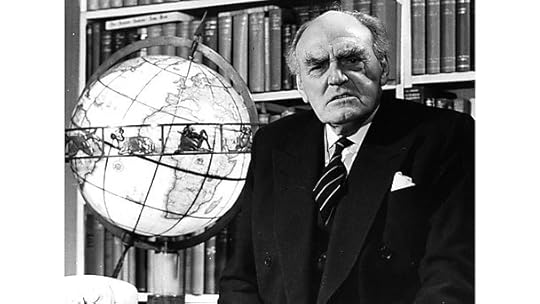
Lord Reith: the best of everything to the greatest number of homes
We act as a central contact point and manage the BBC’s relationships with international technology giants such as Apple, Google, Microsoft and Amazon.
We also work with small and medium sized technology companies to identify ways that we can collaborate with them and help them navigate the BBC.
The BBC has always worked with third party technology companies and in fact our history is closely aligned to such partnerships.
When the BBC was founded way back in 1922 it came about directly as a result of a collaborative effort with a group of radio manufactures including Marconi and General Electric.
Lord Reith (the first director general of the BBC) defined the BBC’s role as “to bring the best of everything to the greatest number of homes” and this is something that we continue to strive for today in the digital world.
A key way of doing this is by partnering with a range of companies and for a wide variety of reasons. To give you a few recent examples of this:
We worked with Microsoft and Inside Secure towards the end of last year to integrate PlayReady technology to protect our programmes, which in turn allowed us to launch mobile downloads for BBC iPlayer.
Adobe is a company that we have partnered with on a range of projects from the launch of iPlayer on the desktop (using their Flash technology) to our recent work with them on the BBC Media Player for Android.
We also recently worked with the Cambridge based audio watermarking company Intrasonics to help deliver the Antiques Roadshow play-along app that we launched in January.
The ‘silent’ audio watermarks are inserted into the broadcasted show enabling mobile and tablet devices to ‘hear’ these audio watermarks which allows the app to know exactly where someone playing along is in the show.
We are always interested in hearing about new innovations that we could potentially bring to our audiences and also on the look-out for partnership opportunities in the digital space that could help the wider industry.
Do get in touch if you have some technologies, platforms or ideas that you think could help us to support the industry and continue to inform, educate and entertain in a digital world.
Cyrus Saihan is head of Business Development, BBC Future Media.
March 1, 2013
What's on BBC Red Button 2 March - 9 March
It's all about music on Red Button this first week of March with highlights from Radio 1's Live Lounge, Emeli Sandé's live concert for Radio 2 and Asian Network classics from the vaults. Sports fans can tune into live indoor athletics, football and rugby league highlights. Enjoy.
Live Lounge

Rita Ora performs in the Live Lounge
Alice Levine brings you highlights from February's remarkable performances in Radio 1’s Live Lounge. Featuring Rita Ora, Jake Bugg, Alt J and Jessie Ware – and some unique cover versions. You can watch Live Lounge acts online too.
Monday 4 March, 12pm-2pm, 6pm-11pm
Tuesday 5 March, 12pm-2pm, 10pm-Wed 6 March, 2pm
Emeli Sandé

Emelie Sande
Watch replays of Brit-award winner Emile Sande performing live in concert in the BBC Radio Theatre in front of an invited audience. You can watch clips of her performance online on the Radio 2 website.
Sat 2 March, 6am-10am
Sun 3 March, 11.40am-2pm, 3.30pm onwards
Mon 4 March, 6am-12pm, 11pm onwards
Tue 5 March, 6am-12pm, 2pm-7pm
Wed 6 March, 2pm onwards
Asian Network Gold 2013
Asian Network Gold celebrates 100 years of the Indian Film industry by delving into the archives and unearthing some iconic interviews and performances from some of the biggest stars who featured on the BBC since the 1970s.
This special programme charts the journey of how Bollywood became the largest film industry in the world from the first ever film shown in 1913. It features interviews from Bollywood's leading stars from legends including Rajesh Khanna, Raj Kapoor and Dilip Kumar to recent celebrities such as Shah Rukh Khan, Madhuri Dixit, Sri Devi, Anil Kapoor and Salman Khan who took the industry global.
6am Thursday 7 March to 2.30pm Saturday 9 March
Sport highlights
Watch live Indoor European Championship Athletics as well as highlights on the Red Button.
For the latest information see the BBC Sport website and the BBC Red Button schedule. Times subject to change at short notice.
In It To Win It Play Along
Dale Winton's In It To Win It, the game show where people use their general knowledge to win a big-money jackpot, is back. Think you can do better than the studio contestants? Every Saturday press the Red Button during the show to pit your wits against our studio contestants
Sat 2 March, 8:25pm-9:15pm
Sat 9 March, 8:25pm-9:15pm
Links: BBC Sport app on Android and Encrypted Media Extension
Hi everyone, here’s another round-up of some stories about BBC Online over the last fortnight.
The launch of the BBC Sport app on Android was widely reported last week as The Next Web observed:
“The broadcaster is not without competition though as UK radio station TalkSport recently launched its apps for Android and iOS for English Premier League radio coverage outside of mainland Europe. It will be interesting to see how BBC Sport’s apps perform when they are all available to a global audience. With tech as a facilitator, the language of sport is bound to travel far and wide.”
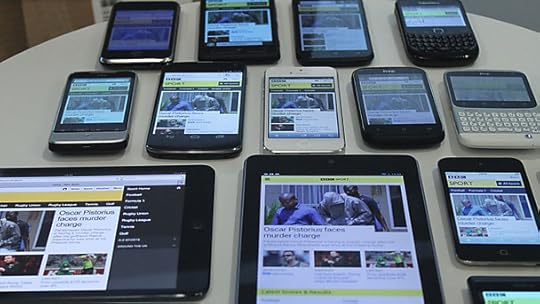
BBC Sport iPlayer app on Android
While just a few days later it was announced the app hit one million download requests.*
The new update to the BBC iPlayer iOS app was also extensively covered and as Pocket-lint reports:
“One commenter has also pointed out that the improved Airplay mode no longer starts a show from the beginning if you pause and go to another app.”
Two weeks ago the BBC published its view on the Encrypted Media Extensions Proposal on the World Wide Web Consortium’s mailing list. You can read it in full here.
It provoked negative reactions from Computer World UK and Cory Doctorow.
Hacker News Forum hosted a discussion on the arguments for and against the BBC’s position.
Martin Belham wrote a blog post at the weekend on ‘What do the Pollard transcripts tell us about the BBC, Jimmy Saville, and comment moderation?’ Martin claims the transcripts “give an interesting insight into what senior BBC management understand their comment moderation policies to be” and goes on to say:
“What strikes me from the rest of this section of the transcript is the extent to which senior BBC management is vague about the process of inviting user comment, and entirely divorced from reading it.”
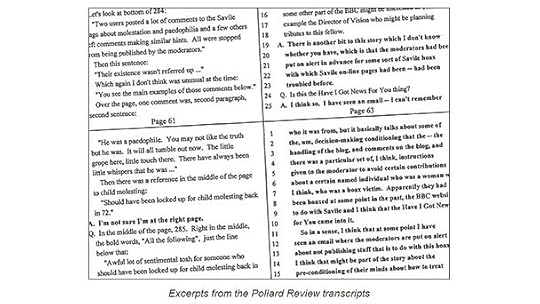
Paul Clayton from RNIB, the Royal National Institute of Blind People reviewed the accessibility of BBC iPlayer concluding that “The BBC iPlayer website has a really easy layout and this makes it possible to find most things quickly using a screen reader […] the fact that the BBC iPlayer online service offers audio described content makes it stand out from most of the other services."
However he also noted that “It is not possible to download audio described content or to stream such content as it is being broadcasted […] Furthermore, the delay in putting up programmes with audio description is another problem, given the fact that the same programmes without this feature are put up almost immediately after they have been aired.”
Last week BBC Connected Studio simultaneously held their Knowledge and Learning Creative Studio in Glasgow, Salford and Cardiff.
As attendee Matt Edgar blogged:
“I found myself in a team that wanted to put a “local lens” on the wealth of learning material that the BBC has amassed over the years. I’m always surprised and humbled when I get the chance to explore early stage ideas with potential users, so the 15 minute audience we had with three regular BBC users was a particular highlight for me.”
You can check out the BBC Internet live blog of the event which collates tweets, picture and even videos from the attendees across the three locations.

The Connected Studio live blog
Finally, communications agency Rule 5 blogged about their trip to Salford yesterday for the RTS BBC Future Media showcase.
“As a comms agency, we were there to glean an insight into how we might utilise developments in our constantly evolving outreach strategies, but it’s not that clear cut. How do you keep up with the Meta Data technology that created ‘Perceptive Media’ – adapting the viewing experience in line with your social cues to ensure that broadcasts are tailor-made to each individual?"
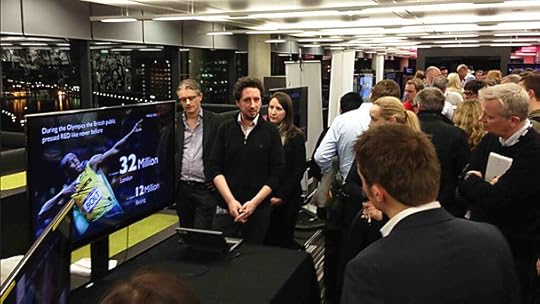
The RTS - BBC Future Media Event in Salford
That’s all folks, have a great weekend wherever you are.
Eliza Kessler is the content producer on the BBC Internet blog.
*Correction: This blog post originally stated the BBC Sport iOS app attained one million downloads, it was infact the iOS and Android versions combined. This has now been updated.
BBC Sport website refresh: a new look and consistent design
Hello my name is Neil Hall and I am the executive product manager responsible for the development of the BBC Sport website.
This January was the biggest month ever for BBC Sport outside of the Olympics with 42 million browsers and over one billion page views of the website.

Old look and new look responsive BBC Sport site
We’ve also just reached one million UK downloads for the BBC Sport smartphone app for iOS and Android.
With such strong audiences it is therefore fitting that for the first time in over eight years we are able to offer a consistent design and user experience across all of the BBC Sport website’s pages.
From taekwondo to tennis, Salford Reds to Manchester United and Six Nations fixtures to horse racing results every page has a consistent look and navigation 12 months on from our relaunch of the site in February 2012.
As soon as the dust settled after the Olympics our team in Salford turned their attentions to delivering the final elements of this consistent user experience, leveraging the technology we delivered for London 2012 to ensure a lasting legacy for UK sports fans.
We efficiently reused or repurposed components built for the relaunch of the Sport website, the Olympics website and from our colleagues in BBC News.
This allowed us to deliver these pages across our desktop site and where possible for the new responsive mobile site and app too, in line with our strategy of building once and delivering across as many screens as possible.
Without the benefit of this technology previous refreshes of the BBC Sport site had foundered, with the design of smaller sports pages and team pages in particular being held back by technology, resource and time constraints.
The older site was built using a static publishing model that meant we had to create a ‘template’ for every view of our content we wanted to present to the audience, making it much more costly to repurpose and deliver to different sections of the site and across mobile too as the pages were created bespoke for each sport.
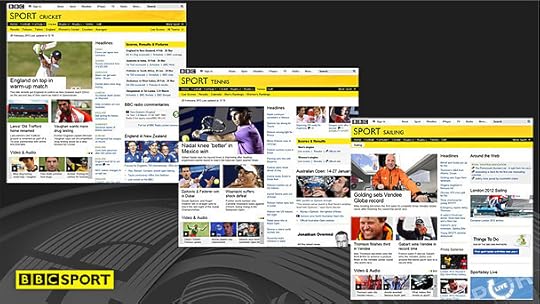
A consistent design across pages
Pre-Games last year only the high-traffic areas of the site were in the new-look and after the Olympics there were still over 350 pages of the site still to be updated.
These pages fell into four key areas for development: team pages, smaller sports homepages, blogs and statistics.
Working in the same way as our football site, we have used linked data to power new team pages across cricket, rugby union and rugby league with a single shared template across all sports.
Journalists tag BBC Sport’s content objects such as a story or a video with the team name or competition they are relevant to.
The linked data stores these semantic tags and a generic metadata model about each piece of content, providing an API to allow the retrieval of relevant content about each team or competition that is then dynamically aggregated in a PHP-based Page Assembly Layer (PAL), the Sport PAL app.
We used the same application to aggregate content around ‘smaller sports’ like taekwondo, fencing and ice hockey, again making use of linked data.
As both areas of the site were in our Sport PAL app we were able to share page components with the rest of the site.
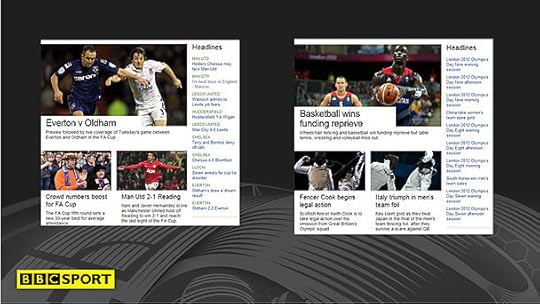
FA Cup and fencing
For example in the screenshots above you can see how the headlines area of the fencing page is exactly the same as our FA Cup page.
The component is the same all that has changed is the content being provided to it by linked data.
In addition to this, leveraging the work already done by our BBC News colleagues, we were able to reuse their blog application to replace Sport’s ageing blog platform.
The blog application is another PAL app, this time it is powered by a separate feed of our journalists most recent content from our syndication platform.
With minimal design changes we were able to use this to neatly bring together all the latest work of our top writers, for example Phil McNulty and David Bond, in the same way that it does for Business editor Robert Peston.

Old and new look blog pages
The final piece in the jigsaw was our statistics pages. It is in this area we had the most ground to cover, 175 pages, and it is here that we delivered the most innovation demonstrating how we will be working in the future.
We built a responsive ‘Generic Stats’ application that for the first time simultaneously delivers content across multiple sports to both the responsive mobile site and desktop site.
The PHP or page assembly layer obtains all the statistics content it needs from the Sports Data API.
The Sport PAL app then converts the raw data into a generic tabular dates model which is passed to the view template for the page.
The page is then served to the audience. This enables all the sports statistics pages to effectively use one template whether the sport is cricket, golf or anything else.
Since we assemble a single page for each request it also means that we become extremely cacheable and can benefit from efficient serving of pages using HTTP caching with Varnish and Content Delivery Networks (CDNs) in order to reduce the load on our own servers, crucial for high-traffic periods around busy sporting moments.
Rather than optimise for one particular view of the content we have built it responsively so that it adapts and displays the content in a way which makes the most of the device's screen size.
We used the same code as the new BBC Sport mobile site to do this, enhancing it to respond not only the size of mobile device someone may be viewing the content on, but also to offer a ‘desktop’ view of content for our audience on computers.
This means the new pages not only finish the desktop ‘Sport Refresh’ project for us, they also deliver new-look scores pages for the new mobile browser site and iOS and Android apps in the coming weeks.
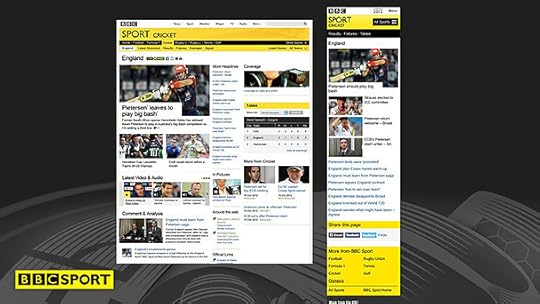
New look mobile site
It is this approach that best represents our strategy for how we want to develop BBC Sport’s services in the future.
We hope you enjoy using the BBC Sport website and are always keen to hear your thoughts on its development, please get in touch to let us know your view on these recent changes.
Neil Hall is executive product manager for the BBC Sport website.
February 27, 2013
Quality Control for file-based delivery at the BBC
Hi my name's Rowan and I work in a small team who look after the technology strategy for the TV making parts of the BBC. That includes everything from cameras and edit platforms to programme delivery and archive.
We work with production teams and other BBC users to understand what they need and design and deliver technology solutions to meet those needs.
We also help users across the BBC to understand new technology and how it might help them or enable them to work in ways which might be quicker, easier, cheaper or enable greater creative flexibility.
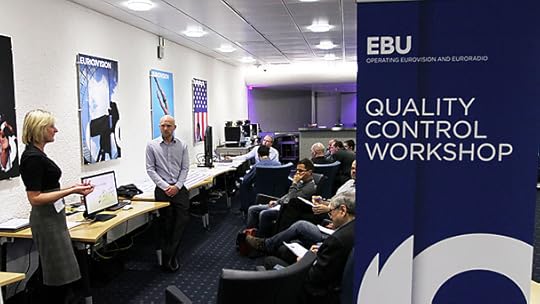
European Broadcasting Union Quality Control workshop
Right now a lot of what's keeping me busy is related to file-based delivery and in particular Quality Control (QC). I've been speaking on the latter topic today at the Broadcast Video Expo in London and I wanted to share the story here too.
Believe it or not finished TV programmes at the BBC, as at most broadcasters, still generally get laid onto digital video tape in order to be shipped around the country, sent to our playout centre and archived on a shelf.
In an environment where we shoot on file-based cameras, edit in file-based suites and play out from servers you could say that's a little crazy.
However, transitioning to an end-to-end file-based process without disrupting the production and broadcast process and without affecting the quality of our output is a big piece of work. Yet it also provides a huge opportunity to improve the way we do certain things and one of those things is quality control.
In a tape-based world we review every programme tape in a high-quality viewing environment with lots of technical kit like oscilloscopes and audio meters. We call this process Technical Review, though it checks for a huge range of errors from making sure that the video and audio signals comply with international standards, to making sure the pictures are in focus and the credits are spelled correctly.
This ensures that the progamme will pass through the playout systems, transmitters and your TV without being degraded or causing equipment to fail and makes sure the finished product looks good once it gets there.
In a file-based world we'd like to remove a lot of those real-time, expensive and old-fashioned bits of equipment and replace them with an automated, software-based analysis system.
That would leave the human 'eyeball' check to focus on those more subjective issues like colour balance, graphics and general picture quality, taking the real technical headaches away.
I've been working on this project for almost two years now, starting with an assessment of the QC tools that are now available on the market and then looking into how we can use them in our workflows.
For example, wouldn't it be better if an editor could get the results of the QC test while still in the edit suite rather than waiting two days to ship a tape, book a Technical Review and get a response? Then any issues could be fixed straight away.
We've also been working with the wider industry on this transition as the BBC certainly isn't unique in using this technology!
Myself and Andy Quested are involved with the European Broadcasting Union's (EBU) strategic programme on Quality Control where we're trying to ensure that all the vendors and all the broadcasters in the group agree on common standards and terminology for the sorts of tests we do.
Within the UK the Digital Production Partnership (DPP) is looking at which of these tests are needed for new programme delivery with the aim of having a relatively standard process across all the UK broadcasters.
That would make it easier for independent production companies and facilities houses who provide programmes and services to many different broadcasters.
All in all we have one simple aim: to ensure that the TV we broadcast to you is of a high technical quality whilst spending as little of your license fee on that process as possible so that as much money as possible goes into making programmes in the first place.
We're on a long journey of changing and improving the QC process with much still to do but there are exciting times ahead.
If you have any questions or comments please feel free to leave a response below.
Rowan de Pomerai is a technologist in BBC Technology, Distribution & Archive.
February 22, 2013
What's on BBC Red Button 23 February - 2 March
We’ve got something for everyone coming up on Red Button this week. Music fans can join Brit Award-winner Emeli Sandé in concert, sports enthusiasts can continue Six Nations fever as we bring you highlights from the tournament, and if your kids are not ready to go back to school just yet, then make sure you press Red for the Dumping Ground interactive quiz. Enjoy!
Emeli Sandé

Watch Brit Award winner and star of the Olympics ceremonies Emile Sandé give an electrifying performance for an intimate audience at the BBC Radio Theatre.
Available on all platforms: Thu 28 February, 7.30-9.30pm; Fri 1 March, 9pm-12.45am; Sat 2 March, 4-6am
The Sound and the Fury

Watch full performances from ensembles including the London Sinfonietta filmed especially for BBC Four's The Sound and the Fury: A Century of Modern Music season. This week features music by John Cage, Morton Feldman and George Benjamin. Watch the programme exploring how the last 100 years have changed music, and then press red to see the special performances in full.
Available on all platforms: Tue 26 February, 10pm-6am; Wed 27 February, 6-7am, 9.45pm-6am; Thu 28 February, 6-7am, 9.30pm-6am; Fri 1 March, 6am-7am, 1.30-2.30pm; Sat 2 March, 12.45-4am
Dumping Ground Quiz
If your kids have been enjoying CBBC's drama The Dumping Ground then they'll love The Dumping Ground Quiz hosted by Tyler and Carmen. There are 11 questions to test their knowledge, simply answer by pressing the coloured buttons on the remote control. So press red and get them involved!
Available on Sky/Freeview only: Mon 25 February, 7am-7.30pm; Tue 26 February, 7am-6.45pm; Wed 27 February, 7am-7.30pm; Thu 28 February, 7am-7.30pm; Fri 1st March, 7am-12.00pm, 2.30-7.00pm
4 O’Clock Club
Get your youngsters to grab their sandwiches and do up their ties because CBBC Extra is going back to school! Press Red to join Cel and Hacker as they introduce a wealth of visual goodies celebrating the return of CBBC’s The 4 O’Clock Club!
They can see what happened when Hacker visited The 4 O’Clock Club’s home, Elmsbury Academy, in search of some new additions for his imaginary talent agency, catch up on some totally cool character profiles and watch an exclusive sneak peek of a never-before-seen episode!
Available on all platforms: Sat 23 February, 7am-2.30pm; Sun 24 February, 12-1pm
CBeebies Red Button
CBeebies Red Button welcomes younger viewers and grown-ups with a sense of adventure to the big, bright and fun world of CBeebies interactive!
Your children's favourite characters are at the heart of the interactive TV experience. Satellite and digital terrestrial viewers will have slightly different offerings from one another. This has enabled the Red Button team to offer the best games tailored to each system.
CBeebies Red Button is available on the CBeebies channel. Visit the CBeebies website to find out more.
Available on Freeview and Sky only
BBC Sport
Catch up on all the latest Sport here on Red Button. This week's sporting highlights include:
For the latest information refer to the BBC sport website and Red Button schedule.
**Note all Red Button times are subject to change at short notice**
Red Button digital text changes
We have recently made some changes to the BBC's Red Button text services. We performed some technical work behind the scenes to remove the final parts of the publishing processes still powered by the recently discontinued Ceefax service.
We’ve tried to keep any changes to the public service to a minimum, but there will be some alterations to the content provided. Details of the changes are listed on the Red Button service on p998.
Designing the Connected Red Button
Hi I'm Robin Gibson, a senior user experience designer in BBC Future Media and worked on BBC Connected Red Button.
Connected Red Button reinvents traditional Red Button bringing BBC online to the living room.
The service launched on Virgin TiVo platforms in December 2012 and the BBC will be rolling it out to other connected TVs during 2013.
We thought now would be a good time to share some of the thinking behind the design approach.
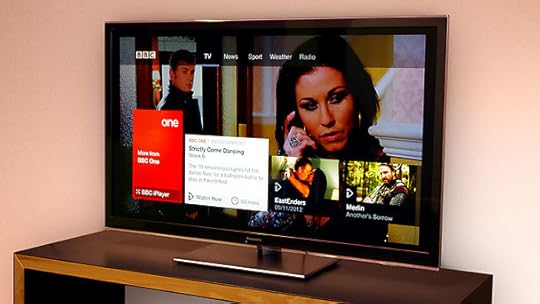
The live service
The project began in mid 2011 when the design team received the brief for a reimagining of the Red Button service for connected TVs.
The vision was to provide the foundation for interactivity around the BBC’s television channels and to set the benchmark for delivering internet driven content across broadcast.
The brief was to be both progressive yet instantly familiar, continuing to embrace the features that make traditional Red Button a successful service today.
Background
With the brief in hand we began a period of research into audience needs whilst examining existing products and interaction patterns on TV.
We obviously knew a great deal about current Red Button usage, but what did users expect from a future service?
Commissioning audience research enabled us to define core principles that sit at the very heart of Connected Red Button.
These are:
• Radical simplicity
• Seamless, satisfying journeys between broadcast and on demand services
• A shared, safe experience
• Exploratory
• Personal
These principles would act as our design compass, helping to keep the team on track throughout the project as we strove to match then exceed audience expectations.
A product vision, a whole batch of research, design principles, mood boards, personas and user requirements meant we where ready to start design exploration.
Whilst the current suite of BBC iPTV applications (BBC iPlayer, News and Sport) certainly gave us a great foundation for the Connected Red Button service, the challenge before us was how could we offer users a gateway between these apps and bring the world of BBC iPTV under one umbrella?
Retaining the broadcast
Very loose sketches (or scamps) of layouts where thrown around, sticky notes and paper prototypes littered desks and walls. Ideas where dismissed as quickly as they where drawn up.
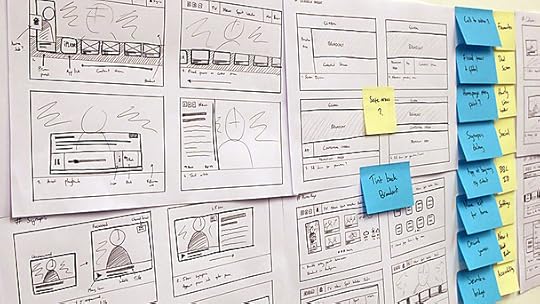
Finding space on the design wall was a challenge in itself
The decision to retain the full screen broadcast in the background of the UI (User Interface) rather than a more conventional quarter screen view (where the broadcast is minimized into a small box) informed every aspect of the design.
The positioning of the content stream, the synopsis rollover and even colour pallete where all informed by this decision.
The retention of full-screen broadcast meant the UI needed to not distract from the background video, presenting the team with a number of challenges.
This left us with a precarious balancing act of trying to reserve as much real estate on the screen as possible for the broadcast whilst still trying to display the Red Button UI in a highly visible manner.
No easy task when minimum font sizes are double those found online.
Global Navigation
Early on in the project we knew the desire of the BBC’s One Service strategy was to maintain the BBC global navigation across mobile and desktop devices and transfer it to the television experience.
This means that regardless of the device being used to access BBC content a product will feel inherently familiar to the user.
This led us to divide the UI into two paradigms: global and contextual.
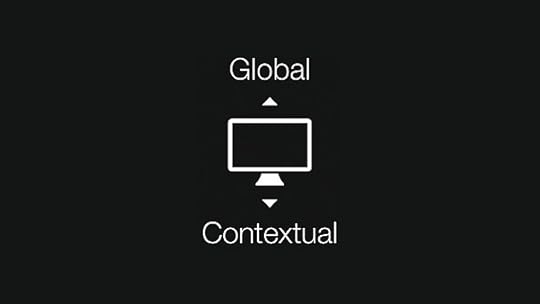
Simplicity remains at the core of Connected Red Button navigation
Global Navigation would sit at the top of the screen while contextual navigation is displayed in a single stream of content at the bottom displayed as selectable images. A large portion of the screen is thereby reserved for broadcast.
At the left of each stream of content we have a menu block that took inspiration from the visual language of smart phone applications.
These menus included ‘launcher’ items that load dedicated BBC full-screen applications (including iPlayer, News and Sport) enabling users to discover a range of additional content.
Efficient design
Constraints are the foundations of great design and having such a relatively small portion of the screen to deliver content forced us to be efficient in a way that might not have been the case had we had the luxury of a full screen interface.
Navigation itself, restricted to the directional buttons of a standard TV remote control (we ruled out the use of colour keys) meant that every journey needed to be purposeful.
Font sizes on television need to be much larger than on other devices and combined with limited screen real estate this meant every bit of space mattered.
Initial explorations emphasized that to fit a meaningful amount of additional content onscreen required us to truncate titles and headlines, even before considering what would happen to the programme synopsis.
We had an aspiration to have the synopsis at the top layer but this was proving problematic. This is because we always felt this information could help inform the users journey, especially as they could potentially be moving away from a programme that they are currently watching.
We therefore decided to scale the highlighted item and use this enlarged area to present the synopsis.
This improved the users focus, provided enough screen real estate to display full titles for the vast majority of content and gave us an opportunity to reveal the synopsis over the image whilst not infringing too much onto the underlying broadcast.

The synopsis rollover was to become one of the defining features of the Connected Red Button
Test, test and test again
Test early, test often is a widely used UX principle. Observing people interacting with your interface is invaluable and also means that issues become apparent very quickly and enable designs to be rapidly redrafted in response.
The prototypes we tested were designed and built to simulate the true experience of using the software on the target device, representing frame-rates and loading times.
The sessions themselves took place in a mock living room with a high fidelity prototype running on a TV. All users interacted with the TV in the normal way using a remote control.
Test participants were matched to a range of profiles representative of our audience mix.
We used a range of testing techniques including guerilla tests, formal task-based testing in the lab and wider hall testing (often with several hundred users) in order to determine the value and usability of each design phase.
Typically sessions were broken up into three parts: explore, task completion and reflective feedback ensuring we covered off all usability questions.
The UX team was supported by the BBC Usability and Accessibility team who provided expert assistance in designing task based questionnaires, recruitment, facilitation and delivery of testing sessions. They also audited the product against internal accessibility criteria.
Although extremely positive, the sessions highlighted a major issue with the discovery of the underlying applications that the Connected Red Button links to.
The visual treatment of the application launcher at the beginning of the stream was being mistaken for a heading therefore users didn’t realize this was a clickable item, missing the onward journeys into the applications.

Early designs featured a smart phone esq visual link to the underlying applications
This part of the interface was certainly the most problematic. Numerous versions were tested and failed. This may be because the concept of an app wasn’t as widely understood in a television context as it is in say a smart phone.
We ripped up that section and started afresh, introducing a BBC branded stream heading instead (i.e. BBC iPlayer, BBC Sport etc) alongside a distinct link to the application.
The concept of filtering the stream came out of this approach as user feedback led us to believe that there was a convenience in retaining the background broadcast whilst browsing through content.
The shape of the project evolved and vertical navigation was introduced to enable us to filter the stream by category.
As a team we did have some initial reservations about whether we where adding a layer of complexity to the product that had the potential to confuse our less tech savvy audience, but the beauty of testing allows us to try out such concepts before they see the light of day.
The sessions went remarkably well, better than we anticipated. Users were able to access the underlying apps as well as browsing a large volume of content at the Red Button level.
The design was beginning to function in the way it was intended.
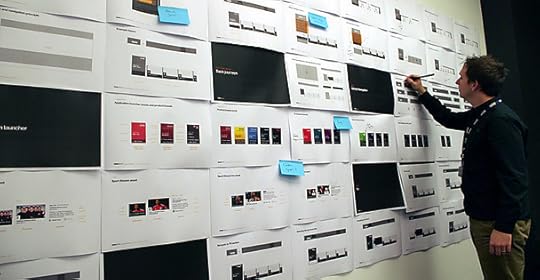
Documenting and iterating designs based on user research
Beyond Connected Red Button
2013 will see a series of new features being released on Connected Red Button as well as scaling up the service to be available on a wider range of connected TVs.
We are constantly looking to make improvements to the service as well as exploring new concepts such as companion experiences and how we can expand on the foundations of Connected Red Button to bring programmes to life on multiple screens.
The future of Connected Red Button is genuinely very exciting.
Thank you for taking the time to read this blog and I hope you enjoy using the service now and in the future.
Please let us know what you think of the design by leaving a comment below.
Robin Gibson is a senior user experience designer in BBC Future Media. This post is a collaboration between Robin and fellow senior user experience designer Wez Elliot.
February 19, 2013
BBC Sport app launched on Android
Hi I’m Keith Mitchell, technical lead for BBC Sport’s mobile services including the new responsive mobile sport web site and the native BBC Sport apps.
I know from the comments on Lucie McLean’s last post that many of you have been waiting for this so I’m very pleased that from today Android users can get access to BBC Sport through an app.
The launch of the BBC Sport app for the Android platform today is another important step in serving sports fans across multiple platforms.

In this post I will summarise the key features relating to the Android release and provide a glimpse into what to expect next from us.
Previous posts by Ben Gallop and Lucie McLean described the main features of the mobile sport site and the iOS app.
The core feature set of the Android app remains consistent with iOS and briefly comprises of the following for all versions of Android from 2.2 Froyo and above:
Top stories and breaking news from a wide range of sports.Live text commentaries on all the big football fixtures, from all the major events and the daily Sportsday live.
A whole new football section which includes fixtures, results and live scores for each competition and league.
Pages for every UK football match and the latest football transfer gossip.
Live video streaming and video clips accessed through media asset pages.
The ability to share pages with your friends, through email, Facebook and Twitter.
Since the launch of the iOS app in the UK last month we have added team pages and media to our mobile web site which are also available in the Android app and the UK and International iOS apps.
The football team pages include top stories, links to team specific fixtures, results and competitions in which they compete. Over the coming weeks we’ll add more functionality to these pages.
We now support the playback of audio and video clips and live video streams within the Android app on versions of Android based around 2.2 (Froyo) and above.
For some handsets this means that unfortunately video playback may not be possible and for some devices this will mean the installation of the BBC Media Player.
For full details on what devices we support please see our mobile media frequently asked questions (FAQs) page.
One additional benefit to the release of the Android app is that it scales to small tablet devices. We have ensured that the app scales well to support newer smaller seven-inch tablets like the Nexus 7 and the Amazon Kindle Fire family of devices.

A version of the Android app will be made available through Amazon marketplace very shortly but in the meantime you can experience the mobile optimised web site.
Our new mobile sport site and native apps herald the beginning of a range of changes you should expect to see over the coming months on these platforms.
For the sport mobile site our ‘responsive design’ and ‘mobile-first’ approach allows the audience experience to be tailored to the capabilities of the device being used to view the site.
What you will notice is that the same web-based text news, commentaries, fixtures, results and live scores content is delivered in the browser and in the app to all mobile devices we support including Blackberry and Windows Mobile.
Our development of sport apps has focussed around the Android and iOS platforms as they account for approximately 75% of smartphones in the UK but we will continue to review the smartphone market.
Following our experiences of developing the native iOS and Android apps for the London 2012 Olympic Games we have continued to follow the hybrid native app approach for our sport apps.
By doing this we are able to surface the same content within our apps using WebViews. This allows the native apps to contain every feature found on the website and ensures that everything we do for big sporting events, such as the World Cup, are always available in the app in future.
Being able to deliver and support such a wide variety of devices across both web and app creates a significant challenge for our engineering and test team.
To meet this we have a behaviour-driven development (BDD) engineering process focused around code quality, maintainability and most crucially testability.
Before I go I thought I’d reveal just a couple of features we are currently working on and which you should expect to see shortly. These include customisable quick links for the main navigation, team customisation and home screen widgets.
We’d love to hear what you think about our new Android app so far and the features now available across all mobile platforms.
Keith Mitchell is the technical lead for BBC Sport mobile.
Linked Data: Connecting together the BBC's Online Content
Hi I’m Oli Bartlett, product manager for the BBC's Linked Data Platform.
The Linked Data Platform is one of the legacies of the BBC Sport 2012 Olympics website. You may have read my blog post on the work we did for the Olympic Data Service.
One aspect of the service delivered the semantic framework for the 10,000 athlete pages and a page per event, discipline, country and venue.
This framework provides the semantic graph of data (the linked data containing the athletes, events and venues and their associations with each other) and the APIs on this data.
It was all built on the Dynamic Semantic Publishing (DSP) platform which facilitates the publication of automated metadata driven web pages and had originally been developed for the football World Cup in 2010.

The Linked Data Platform
The Linked Data Platform is the natural evolution of DSP. It builds on the idea of applying semantic tags to News and Sport articles by allowing tagging of any BBC content.
Also it provides the processes and tools needed to store and query linked data in any subject which may be of interest to the BBC from the original sport data (football and Olympics) to the UK schools’ curricula, politics, nature, music and more.
I'm getting a little ahead of myself. It will do these things but we're not quite there yet. Let's wind back a bit.
Every day the BBC creates thousands of creative works for its website including news articles, television and radio programmes, blog posts, recipes and learning resources to name a few.
Each of these content types is stored in a content management system (CMS) along with its own set of metadata appropriate for how the content is used.
For example we store the contributors to TV programmes in our programmes database, PIPS, the published date of News articles in our News Content Production System and the cuisine for a recipe in the recipes database.
The evolution of a CMS tends to be driven by the audience facing products it powers, so new metadata or features will be added as needed by its partner product(s).
This isn't unusual for a web platform and works perfectly well for our products. It does however mean that a CMS doesn’t tend to be optimised for making the content more accessible to other products and services in the BBC or to the wider web.
The Linked Data Platform stores a generic metadata model for each creative work published along with its semantic tags.
This model contains useful attributes which are common across all types of content which makes it much easier to build products which can combine content from different systems.
This in turn allows producers to focus on the stories they’re trying to tell by using the most appropriate content from across the BBC.
As we create more and more content it becomes harder and harder to keep track of everything that's there, for both our audience and producers alike.
Individual CMSs are pretty good at keeping tabs on the content they create but if you wanted to get hold of the 20 most recent pieces of content from across the BBC (and hence across CMSs) on Burkina Faso, or Jarvis Cocker or global warming it would be very tricky.
Free text searching (like a Google search) would get you so far but would probably return false-positives too (it can’t disambiguate between Shakespeare and Shakespeare).
It would be even harder (or maybe impossible) to do something more complex like find the latest 20 pieces of content about environmental issues or people who have been in northern Britpop bands. Here text searching starts to become significantly less powerful.
The primary goal of the Linked Data Platform is to make sense of all the BBC's creative works and provide an API to allow the retrieval of any creative work about any 'thing', with the added benefit that we hold a semantic graph of data behind the 'things'.
This means the platform doesn't just know that tomorrow's episode of the Culture Show features Jarvis Cocker. It also knows that Jarvis is from Sheffield, was the lead singer in Pulp, that Pulp were a Britpop band, that they had a single called Common People, and that Common People was played on 6 Music this morning.
We can suddenly start to make connections across our products and content which couldn't previously have been made without a lot of manual effort.
We're only starting to touch the surface of what new stories we'll be able to tell as we build up the content and data in the platform. Matt Shearer has written about how News are looking into new ways of curating content and providing journeys through linked data.
Currently we're working on getting data and content around music, politics, learning and sport (beyond football and the Olympics) into the platform. We're also investigating ways in which to get archived content into the platform as there are huge opportunities for publishing this in new ways using linked data.
If you have any questions or thoughts that you’d like to feedback then please leave a comment below.
Oliver Bartlett is product manager, BBC Linked Data Platform.
February 15, 2013
What's on BBC Red Button 16th – 23rd February
This week on BBC Red Button we've got treats for music lovers with 6 Music Live at Maida Vale concerts replays and BBC Four's The Sound and the Fury. Cycling and Welsh Open snooker are on offer for sports fans while younger audiences will love CBBC's Deadly Extra and the 4 O'Clock Club. Plus find out more about recent changes to our digital text service.
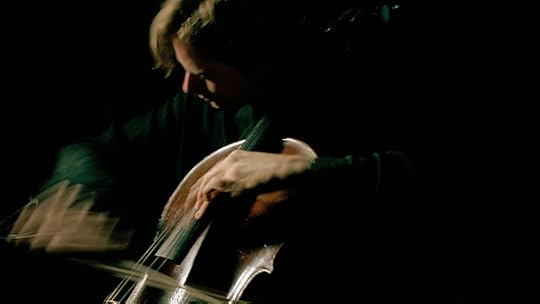
Oliver Coates performs in The Sound and the Fury
The Sound and the Fury
BBC Four's The Sound and the Fury: A Century of Modern Music traces the turbulent history and ground-breaking music of the last century, uncovering how the last 100 years have changed music and the way we listen to sound forever. The series explores why individual composers felt compelled to create the challenging music they did and how they were influenced by the upheavals of their time.
The series features specially filmed performances from a number of ensembles including the London Sinfonietta, which can been seen in full on the Red Button after each programme. This week features music by Arnold Schoenberg, Anton Webern and Charles Ives.
Available on Freesat/Sky/Virgin Media/Freeview:
Mon 18th February, 12:00am-7:00am
Tue 19th February, 9:55pm-6:00am
Wed 20th February, 6:00am-7:00am
Fri 22nd February, 1:25am-4:00am
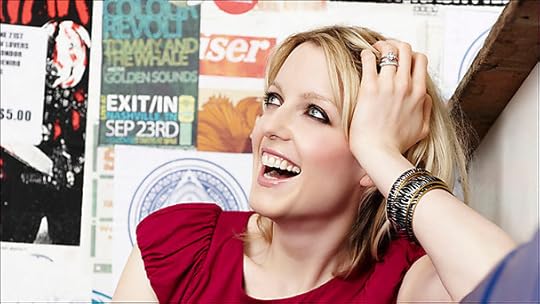
Lauren Laverne presents 6 Music Live
6 Music Live
Lauren Laverne presents 6 Music Live from the BBC’s Maida Vale Studios, hosting very special performances from Suede, Foals, Everything Everything and Richard Hawley. You can find out more and get the full line up at 6 Music Live at Maida Vale
Available on Freesat/Sky/Virgin Media/Freeview:
Sat 16th February, 6:00am-7:00am
Mon 18th February, 7:00pm-11:30pm
Tue 19th February, 4:00am-7:00am
Wed 20th February, 8:00pm-6:00am
Thu 21st February, 6:00am-7:00am, 8:00pm-1:25am
Fri 22nd February, 4:00am-7:00am

Deadly Extra
Deadly Extra
CBBC Extra is taking a walk on the wild side this week by celebrating the brand new and totally brilliant Deadly Mission Madagascar. Join Cel and Hacker as they introduce a wealth of wildlife-inspired telly. Yonko goes all extreme in the great outdoors, Hacker attends the Deadly Mission Madagascar auditions and there’s an exclusive report about wildlife right here in the UK from a Deadly Mission Madagascar crew-member
As always you can read Chris and Dodge’s blog, check out the answers to some of your questions and read your horoscopes as written by Yonko.
Available on Freesat/Sky/Virgin Media/Freeview:
Mon 18th February, 7:00am-7:00pm
Tue 19th February, 7:00am-7:40pm
Wed 20th February, 7:00am-10:00am, 1:00pm-4:00pm, 7:00pm-8:00pm
4 O'Clock Club
Grab your sandwiches and do up your tie because CBBC Extra is going back to school!
Press Red and join Cel and Hacker as they introduce a wealth of visual goodies celebrating the return of CBBC’s The 4 O’Clock Club!
See what happened when Hacker visited The 4 O’Clock Club’s home, Elmsbury Academy, in search of some new additions for his imaginary talent agency, catch up on some totally cool character profiles and watch an exclusive sneak peek of a never before seen episode!
As always you can read Chris and Dodge’s blog, check out the answers to some of your questions and read your horoscopes as written by Yonko.
Available on Freesat/Sky/Virgin Media/Freeview:
Sat 16th February, 7:00am-1:00pm
Sun 17th February, 12:00pm-1:00pm
Thu 21st February, 7:00am-12:00pm
Thu 21st February, 7:00pm-8:00pm
Fri 22nd February, 7:00am-4:00pm
Sat 23rd February, 7:00am-2:30pm
Blandings
Want to take a closer look at the castle and characters in BBC One’s Sunday night comedy? Join us as Beach gives a guided tour of Blandings Castle and its ancestral history - watch out for encounters with some of the residents including the Empress of Blandings, Lord Emsworth's prize Sow.
Available on Freesat/Sky/Virgin Media/Freeview:
Mon 18th February, 11:30pm-4:00am
In It To Win It
Dale Winton’s In It To Win It, the game show where people use their general knowledge to win a big money jackpot, is back. Think you can do better than the studio contestants? Every Saturday press the Red Button during the show to pit your wits against our studio contestants.
Available on Sky and Freeview:
Sat 16th February, 8:10pm-9:00pm
CBeebies Red Button
CBeebies Red Button welcomes younger viewers and grown-ups with a sense of adventure to the big, bright and fun world of CBeebies interactive!
Your children's favourite characters are at the heart of the interactive TV experience. Satellite and digital terrestrial viewers will have slightly different offerings from one another. This has enabled the Red Button team to offer the best games tailored to each system.
CBeebies Red Button is available on the CBeebies channel.
Visit the CBeebies website to find out more.
Available on Freeview and Sky only
BBC Sport
Catch up on all the latest Sport here on the Red Button. This week's sporting highlights include:
Snooker: Coverage of the Welsh Open
Cycling: Coverage of the World Track Championships
For the latest information refer to the BBC sport website and Red Button schedule.
**Note all Red Button times are subject to change at short notice**
BBC's Blog
- BBC's profile
- 28 followers



